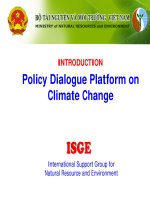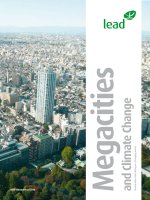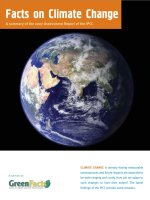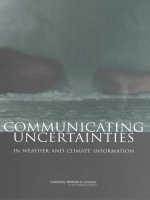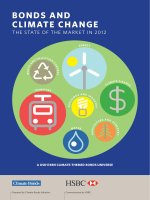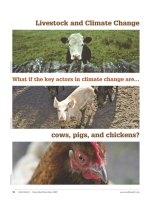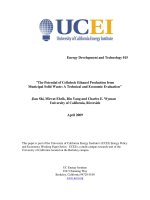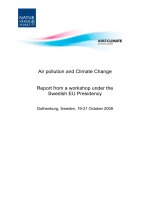Waste management options and climate change doc
Bạn đang xem bản rút gọn của tài liệu. Xem và tải ngay bản đầy đủ của tài liệu tại đây (1.02 MB, 224 trang )
See our publications catalogue at:
/>European Commission
14 KH-40-01-432-EN-N
OFFICE FOR OFFICIAL PUBLICATIONS
OF THE EUROPEAN COMMUNITIES
L-2985 Luxembourg
ISBN 92-894-1733-1
9 789289 41 7334
Waste management options
and climate change
A great deal of additional information on the European Union is available on the Internet.
It can be accessed through the Europa server ().
Cataloguing data can be found at the end of this publication.
Luxembourg: Office for Official Publications of the European Communities, 2001
ISBN 92-894-1733-1
© European Communities, 2001
Reproduction is authorised provided the source is acknowledged.
Waste Management Options
and Climate Change
Final report to the European Commission,
DG Environment
Alison Smith
Keith Brown
Steve Ogilvie
Kathryn Rushton
Judith Bates
July 2001
AEA Technology
Title Waste Management Options and Climate Change: Final Report
Customer European Commission, DG Environment
Customer reference B4-3040/99/136556/MAR/E3
Confidentiality,
copyright and
reproduction
This document has been prepared by AEA Technology plc in
connection with a contract to supply goods and/or services and is
submitted only on the basis of strict confidentiality. The contents
must not be disclosed to third parties other than in accordance with
the terms of the contract.
File reference
C:\0_WORK\PROJECTS\21158001\Final\Waste Management Options and Climate Change KB7.doc
Report number Final Report ED21158R4.1
Report status Issue 1.1
AEA Technology
Culham
Abingdon
OX14 3ED
Telephone +44 (0)1235 463134
Facsimile +44 (0)1235 463574
AEA Technology is the trading name of AEA Technology plc
AEA Technology is certificated to BS EN ISO9001:(1994)
Authors Alison Smith, Keith Brown, Steve Ogilvie, Kathryn Rushton and
Judith Bates
Name Signature Date
Reviewed by Keith Brown
Approved by Debbie Buckley-Golder
This document has been prepared for use within the European Commission. It does not necessarily represent the
Commission’s official position.
Executive summary
Final Report
ED21158 AEA Technology i
Executive Summary
This document is the final report of a study undertaken for the European Commission
Environment Directorate General by AEA Technology to assess the climate change impacts
of options for municipal solid waste (MSW) management in the EU. The study covers the
fifteen member states of the European Union and the time horizon 2000 to 2020.
The study is intended to inform developing EU-level waste policy, in terms of climate change
impacts only. Climate change impacts are only one of a number of environmental impacts
that derive from solid waste management options. Other impacts include health effects
attributable to air pollutants such as NO
x
, SO
2
, dioxins and fine particles, emissions of ozone-
depleting substances, contamination of water bodies, depletion of non-renewable resources,
disamenity effects, noise, accidents etc. These environmental impacts are in addition to the
socio-economic aspects of alternative ways of managing waste. All of these factors need to
be properly considered in the determination of a balanced policy for sustainable waste
management, of which the climate change elements are but one aspect. The study is not
intended as a tool for municipal or regional waste planning, where local factors, such as the
availability of existing waste management facilities and duration of waste management
contracts, markets for recyclables, geographic and socio-economic factors, will exert the
dominant influence.
The study assesses climate change impacts in terms of net fluxes of greenhouse gases from
various combinations of options used for the management of MSW. The waste management
options considered are:
• Landfill of untreated waste. Bulk untreated MSW is deposited in landfills. Alternative
assumptions concerning the control of methane emissions in landfill gas (including the use
of gas for electricity generation) are tested in the analysis.
• Incineration. Options assessed include mass-burn incineration of bulk MSW with and
without energy recovery (as electricity only and combined heat and power - CHP),
refuse-derived fuel combustion and pyrolysis and gasification;
• Mechanical biological treatment (MBT). Bulk MSW, or residual wastes enriched in
putrescible materials after the removal of dry recyclables, is subjected to a prolonged
composting or digestion process which reduces the biodegradable materials to an inert,
stabilised compost residue. The compost, which cannot be used in agriculture or
horticulture because of its poor quality, is then landfilled. The treatment results in a
significant reduction in methane forming potential of the compost in the landfill
compared with untreated waste. Metals are recovered for recycling during the MBT
process. Some of the paper and plastics in the incoming waste are diverted from the
MBT process. These rejects are sent for either direct landfilling or incineration.
• Composting. Good quality garden and food wastes are segregated at source and
composted, producing a bulk-reduced stabilised humus residue of compost that is of
sufficient quality to be marketed as a soil conditioner or growing medium in agriculture
or horticulture. Options of centralised composting facilities and home composting are
considered.
• Anaerobic Digestion (AD). Like composting, this option produces a compost residue
from source-segregated putrescible wastes for use in agriculture or horticulture. The
Executive summary
Final Report
ED21158 AEA Technology ii
waste is digested in sealed vessels under air-less (anaerobic) conditions, during which a
methane-rich biogas is produced. The biogas is collected and used as a fuel for electricity
generation or CHP.
• Recycling. Paper, glass, metals, plastics, textiles and waste electrical and electronic
equipment are recovered from the waste stream and reprocessed to make secondary
materials.
Options are considered for MSW collected in bulk with limited recovery of recyclable
materials and for materials segregated at source for more extensive recycling and (in the case
of food and garden wastes) composting or AD. In addition to MSW, the study also assesses
the greenhouse gas fluxes associated with managing waste electrical and electronic
equipment (WEEE) disposed of with the MSW stream.
The principal processes quantified in the study that lead to positive greenhouse gas fluxes are
as follows:
• Emissions of methane from the landfilling of biodegradable wastes (mainly paper and food
and garden wastes – the latter known collectively as putrescible waste);
• Emissions of fossil-derived carbon dioxide from the combustion of plastics and some
textiles in incinerators;
• Emissions of nitrous oxide during incineration of wastes;
• Emissions of fossil-derived carbon dioxide from the collection, transportation and
processing of wastes, from the fuel used in these operations.
• Emissions of halogenated compounds with high global warming potentials used in WEEE
(as refrigerants and insulating foam in fridges and freezers).
A number of processes lead to negative fluxes of greenhouse gases. These are as follows:
• Avoidance of emissions that would have been produced by other processes – for
example:
- energy recovered from incineration avoids the use of fossil fuels elsewhere in the
energy system;
- recycling avoids the emissions associated with producing materials recovered from
the waste from primary resources;
- use of compost avoids emissions associated with the use of any peat or fertiliser that it
displaces.
• The study also takes account of non-fossil carbon stored (ie sequestered) in the earth’s
surface for longer than the 100-year time horizon for global warming adopted for the
analysis. The main contributors to carbon sequestration are:
- slowly degrading carbon stored in landfills receiving untreated biodegradable waste;
- biodegradable waste stabilised by MBT treatment prior to landfilling, and
- carbon in compost that is incorporated into stable humus in the soil
The net greenhouse gas flux from each waste management option is then assessed as the sum
of the positive and negative fluxes. The study has also gathered information on the costs of
alternative waste management options.
The conclusions are as follows:
Executive summary
Final Report
ED21158 AEA Technology iii
1. The study has shown that overall, source segregation of MSW followed by recycling (for
paper, metals, textiles and plastics) and composting /AD (for putrescible wastes) gives the
lowest net flux of greenhouse gases, compared with other options for the treatment of
bulk MSW. In comparison with landfilling untreated waste, composting / AD of
putrescible wastes and recycling of paper produce the overall greatest reduction in net
flux of greenhouse gases. The largest contribution to this effect is the avoidance of
emissions from landfills as a result of recycling these materials. Diversion of putrescible
wastes or paper to composting or recycling from landfills operated to EU-average gas
management standards decreases the net greenhouse gas flux by about 260 to 470 kg CO
2
eq/tonne of MSW, depending on whether or not the negative flux credited to carbon
sequestration is included.
2. The issue of carbon sequestration is a particularly important for landfills (and for MBT
compost after landfilling), where the anaerobic conditions enhance the storage of carbon.
Carbon sequestration plays a relatively small role in the overall greenhouse gas flux
attributed to composting, because of the relatively rapid rate of decomposition of the
compost after its application to (aerobic) soils.
3. The advantages of paper recycling and composting over landfilling depend on the
efficiency with which the landfill is assumed to control landfill gas emissions. For sites
with only limited gas collection, the benefits of paper recycling and composting are
greater, but less when best practice gas control is implemented. In this case the net
greenhouse gas savings from recycling and composting range from about 50 to 280 kg
CO
2
eq/tonne MSW. If landfills further reduce methane emissions with a restoration
layer to enhance methane oxidation, then recycling and composting incur a small net
penalty, increasing net greenhouse gas fluxes to about 20-30 kg CO
2
eq/tonne MSW, if
carbon sequestration is taken into account. If sequestration is neglected, then recycling
and composting attract a net flux saving of about 50 (putrescibles) to 200 (paper) kg CO
2
eq/tonne MSW.
4. The study has also evaluated the treatment of contaminated putrescible waste using
MBT, which may be appropriate if such waste cannot be obtained at high enough quality
for composting with the aim of using the compost as a soil conditioner. MBT performed
almost as well as AD with CHP in terms of net greenhouse gas flux from putrescible
waste, but this advantage was largely determined by the credit for carbon sequestration.
If this was not taken into account, then composting or AD of source-segregated wastes
remained the best options. Omitting carbon sequestration significantly worsens the
greenhouse gas fluxes calculated for landfills and MBT, but has a much smaller effect on
composting or AD.
5. It must be emphasised that the apparent advantage of high-quality landfilling over
composting and recycling of putrescibles and paper noted above refers only to
greenhouse gas fluxes. Issues of resource use efficiency, avoided impacts due to paper
making from virgin pulp and improvements in soil stability, fertility and moisture-
retaining properties stemming from the use of compost in agriculture must all be
considered as part of the assessment of the overall ‘best’ option. These factors are outside
the remit of the present study, but their inclusion would almost certainly point to
recycling and composting in preference to any form of landfill disposal for these waste
components. Improving landfill gas management to reduce greenhouse gas emissions is
Executive summary
Final Report
ED21158 AEA Technology iv
therefore essentially an ‘end of pipe’ solution, which reduces only one of the impacts of
landfilling biodegradable waste without tackling the root cause.
6. For other materials (glass, plastics, ferrous metal, textiles and aluminium), recycling offers
overall net greenhouse gas flux savings of between about 30 (for glass) and 95 (for
aluminium) kg CO
2
eq/tonne MSW, compared with landfilling untreated waste. For
these materials, the benefits are essentially independent of landfill standards and carbon
sequestration.
7. For mainstream options for dealing with bulk MSW as pre-treatment for landfill, the
option producing the lowest greenhouse gas flux (a negative flux of some 340 kg CO
2
eq/tonne MSW) is MBT (including metals recovery for recycling) with landfilling of the
rejects and stabilised compost. MBT with incineration of rejects (energy recovered as
electricity) gives a smaller net negative flux of about 230 kg CO
2
eq/tonne. Mass-burn
incineration where half the plants operate in electricity only and half in CHP mode gives
a net negative flux of about 180 kg CO
2
eq/tonne MSW. If all the incineration capacity
were assumed to operate in CHP mode, then the net flux from incineration would be
almost the same as from MBT with landfill of rejects. On the other hand energy
recovery from incineration as electricity only would produce a net flux of only –10 kg
CO
2
eq/tonne. These figures are based on EU-average landfill gas control, inclusion of
carbon sequestered in MBT compost after landfilling and the replacement of electricity
and heat from EU-average plant mix.
8. If the benefits of carbon sequestration are left out of the comparison of options just
presented, then the MBT options both produce net positive greenhouse gas fluxes of 23
to 55 kg CO
2
eq/tonne MSW. Incineration is unaffected by assumptions on carbon
sequestration.
9. The performance of MBT with landfilling of rejects is further improved as higher
standards of landfill gas control are implemented, relative to mass-burn incineration,
provided the contribution from carbon sequestration is included. If sequestration is
omitted, incineration continues to perform better than MBT.
10. As stated in point 7 above, under the baseline assumptions used in this study, MBT with
landfill of rejects gives rise to a lower (net negative) greenhouse gas flux than MBT with
incineration of rejects. The main reason for this difference is lies in the source of
greenhouse gas emissions in the two options. In MBT with landfill, methane emissions
from the landfilled material is the main contributor to the positive flux, whilst for MBT
with incineration, methane emissions are much lower but are more than outweighed by
fossil carbon dioxide released from incinerating the plastic rejects. The relative
performance of the two options depends crucially on the effectiveness of landfill gas
control and, in the case of MBT with incineration, the energy source that is displaced by
recovering energy from incineration. In the analysis performed here, we have assumed
that electricity only is recovered, although in some cases there may be opportunities for
recovering heat as well. This would further enhance the performance of MBT with
incineration compared with MBT with landfill. It appears therefore that the choice
between these options will largely depend on local circumstances, although either will
offer a major improvement over current practices of landfilling untreated bulk MSW.
Executive summary
Final Report
ED21158 AEA Technology v
11. The issue of the source of displaced energy is critical to the performance of incineration
in terms of net greenhouse gas flux. The base case is predicated on the assumption that
energy from waste displaces electricity or heat generated at a CO
2
emission factor
representative of average EU power and heat sources. For electricity, there has been an
increasing trend to combined cycle gas turbine technology in recent years, but this has
not been assessed separately because the emission factor from this technology is very close
to average plant mix. Two alternatives to replacement of ‘average’ electricity are
considered. They are (a) replacement of coal-fired power generation, and (b)
replacement of electricity generated from renewable sources – in this case wind. The
example given in (a) could come about, for example, from the accelerated retirement of
an old coal-burning power station due to the commissioning of new incineration
capacity, or through the use of RDF as a coal substitute. Example (b) may result from
the inclusion of energy from waste (ie incineration) technology within a member state’s
target for renewable energy – as is the case in the UK. The greater the CO
2
emission
factor of the replaced generation source, the greater the emission saved due to its
replacement by incineration.
12. Replacement of coal-fired electricity generating plant by mass-burn incineration would
result in a net negative greenhouse gas flux of almost 400 kg CO
2
eq/tonne MSW, with
equal proportions of power only and CHP incineration capacity. Under these
circumstances, mass-burn incineration would give practically the same emission saving as
recycling and composting of source segregated materials. With all incinerators in CHP
mode, mass-burn incineration would be the best overall option in terms of greenhouse
gas flux. Combustion of RDF as a coal substitute in power stations or cement kilns gives
rise to a net negative greenhouse gas flux of about half this sum.
13. A different picture emerges for the situation in which the electricity displaced by
incineration comes from wind power, as an example of low-emissions renewable energy
sources. Here the displaced generation source has almost no greenhouse gas emissions.
In this case, mass-burn incineration is virtually neutral in greenhouse gas terms. In
comparison, MBT with landfill of rejects produces a net negative flux of almost 340 kg
CO
2
eq/tonne MSW, which makes it the best option for non-source segregated wastes.
MBT with incineration of rejects gives a net negative flux of about 150 kg CO
2
eq/tonne
MSW. These comparisons are on the basis of sequestered carbon being included in the
overall flux from the MBT options.
14. If carbon sequestration is omitted, incineration and MBT with landfill of rejects have a
similar net greenhouse gas flux in absolute terms (of 8 to 26 kg CO
2
eq/tonne MSW),
whilst that for MBT with incineration is much higher, at about 135 kg CO
2
eq/tonne
MSW.
15. Alternatives to mass-burn incineration have also been evaluated. From the perspective
of greenhouse gas fluxes, emissions from pyrolysis and gasification are assessed as being
similar to those of mass-burn incineration. Greenhouse gas fluxes from RDF
manufacture and combustion (plus landfill of residues and recycling of recovered metals)
depends highly on the fuel which they replace. Combustion as a replacement for average
electricity plant mix results in higher greenhouse gas fluxes than for mass-burn
incineration, due mostly to methane emissions from the landfilled residue left over from
RDF manufacture. Improvements in landfill site gas control therefore improve the
performance of this option relative to mass-burn incineration, although overall this RDF
Executive summary
Final Report
ED21158 AEA Technology vi
option performs consistently worse in greenhouse gas flux than MBT with incineration of
rejects.
16. Recycling of WEEE containing CFC refrigerants and foam agents now banned because
of their ozone –depleting properties results in a net increase in greenhouse gas flux due to
the escape of some of these agents during recycling operations. This leakage is more than
sufficient to compensate for the considerable greenhouse gas benefits of recycling the
metals from WEEE. Nevertheless, recycling of WEEE containing these materials is far
preferable to landfill, where the greenhouse gas flux would be much higher. The use of
less harmful refrigerants and foam agents and the adoption of more efficient collection
procedures will largely eliminate the net positive greenhouse gas flux associated with
WEEE recycling and result in substantial net greenhouse gas savings, due largely to the
avoided emissions attributable to metal recycling. However, a considerable backlog of
equipment containing CFCs remains to come through to the waste stream over the next
5-10 years and further efforts to minimise the release of GHG during recycling would be
desirable.
17. Overall, emissions of greenhouse gas associated with transportation of waste, residues and
recovered materials are small in comparison with the much larger greenhouse gas fluxes
in the system, such as those related to avoided energy / materials, landfill gas emissions
and carbon sequestration. Variations in emissions due to alternative assumptions about
transport routes and modalities will therefore have a negligible impact on the overall
greenhouse gas fluxes of the waste management options.
18. The study has evaluated four scenarios alternative scenarios of waste management in the
year 2020 and compared the impacts on greenhouse gas fluxes with the year 2000.
Achievement of the landfill directive’s target to reduce the landfilling of untreated wastes
in 2016 to 35% of 1995 levels is predicted to result in an overall reduction in greenhouse
gas flux from a positive flux of 50 kg CO
2
eq/tonne in 2000 to a negative flux of almost
200 kg CO
2
/tonne in 2020. Even if achievement of the directive’s target is delayed
until 2020 (rather than 2016), then a negative flux of about 140 kg CO
2
eq/tonne results.
Further reductions in greenhouse gas fluxes (to about –490 kg/CO
2
/tonne) could be
achieved through investment in recycling, incineration with CHP and MBT.
Alternatively, a scenario with no incineration and maximum biological treatment of
waste achieves an overall greenhouse gas flux of –440 kg CO
2
eq/tonne.
19. The study has also examined the costs of waste disposal through the various waste
management options, as reflected in disposal fees or the prices commanded by recycled
materials. Wide difference in disposal costs exist between different member states.
Landfill disposal, currently the cheapest option, will inevitably increase in cost with the
requirement for higher environmental standards and the consumption of void space as
existing sites fill up and close. Little information is available on the costs of MBT, but
what there is suggests that this option may become increasingly competitive with landfill
and incineration, especially when benefits of increased efficiency of landfill void space use
and lower requirements for gas and leachate control are taken into account. Further
growth in composting and AD for food and garden wastes will depend to a large extent
on continuing success in reducing the costs of separate collection of feedstock and in
establishing local markets for the compost product. Recycling remains highly dependent
on the market value of the recycled product. With the principal exception of
aluminium, the price of materials recovered from MSW does not cover the costs of
Executive summary
Final Report
ED21158 AEA Technology vii
separating and reprocessing, compared with virgin materials, and such operations usually
require subsidy. This is particularly so of plastic wastes. In this instance the option of co-
incineration as a coal-replacement offers comparable greenhouse gas benefits to recycling
but at a substantially lower cost.
20. Overall, the study finds that source-segregation of various waste components from MSW,
followed by recycling or composting or AD of putrescibles offers the lowest net flux of
greenhouse gases under assumed baseline conditions. Improved gas management at
landfills can do much to reduce the greenhouse gas flux from the landfilling of bulk
MSW, but this option remains essentially an ‘end of pipe’ solution. Incineration with
energy recovery (especially as CHP) provides a net saving in greenhouse gas emissions
from bulk MSW incineration, but the robustness of this option depends crucially on the
energy source replaced. MBT offers significant advantages over landfilling of bulk MSW
or contaminated putrescible wastes in terms of net greenhouse gas flux.
21. It must be emphasised that in practice other impacts of waste management options will
need to be considered in addition to just greenhouse gas fluxes. These wider
considerations will include factors such as resource use efficiency (which will, for
example, impinge upon the choice between the disposal option of MBT and the recycling
option of composting or AD) and the impacts of other emissions such as those associated
with waste incineration. Furthermore, substantial environmental benefits are associated
with the use of compost to improve soil organic matter status and more environmentally-
benign methods of cultivation, but only the relatively modest benefits associated
specifically with greenhouse gas fluxes have been considered in this study.
Acknowledgements
The project team wish to thank the numerous individuals and organisations who contributed information
during the preparation of the draft report and to members of the expert review panel for their constructive
and insightful comments during the finalisation of the study. The views expressed in this document are
those of the authors and not necessarily those of the European Commission or any other body.
Abbreviations
Final Report
ED21158 AEA Technology ix
ABBREVIATIONS
AD Anaerobic digestion
Al aluminium metal
CCGT Combined Cycle Gas Turbine
CF
4
Carbon tetrafluoride
CFC Chloro Fluoro Carbons
CH
4
Methane
CHP Combined Heat and Power
CO
2
Carbon dioxide
CV Calorific Value
DDOC Dissimilable Degradable Organic Carbon
DOC Degradable Organic Carbon
EC European Commission
EU European Union
FBC Fluidised Bed Combustor
Fe iron (ferrous metals)
GCV Gross Calorific Value
GHG Greenhouse Gas
GJ Giga Joule
GWP Global Warming Potential (of greenhouse gases, relative to CO2, over
a specified time horizon)
HCFC Hydro Chloro Fluoro Carbon
HDPE High Density Polyethylene
HFC Hydro Fluoro Carbon
HHW Household waste
IPCC Intergovernmental Panel on Climate Change
kg kilogram
kt kilotonnes
kWh kilowatt hour
LDPE Low Density Polyethylene
LLDPE Linear Low Density Polyethylene
MBT Mechanical and Biological Treatment
MJ Mega Joule
MRF Materials Reprocessing Facility
MSW Municipal Solid Waste
Mt million tonnes
N
2
O Nitrous oxide
NCV Net Calorific Value
OCGT Open Cycle Gas Turbine
PE Polyethylene
PET Polyethylene terephthalate
PP Polypropylene
PVC Polyvinyl chloride
RCV Refuse Collection Vehicle
RDF Refuse Derived Fuel
RTS Refuse Transfer Station
t tonne
TJ Tera Joule
WEEE Waste Electrical and Electronic Equipment
Waste Management and Climate Change Final Report
ED21158 AEA Technology xi
Contents
Executive Summary i
Acknowledgements vii
Abbreviations ix
1 Introduction 1
1.1 THE AIM OF THIS STUDY 1
1.2 WASTE MANAGEMENT AND GREENHOUSE GASES 2
1.3 WASTE MANAGEMENT POLICY IN THE EU 3
1.4 STRUCTURE OF THE REPORT 4
2 Approach and methodology 7
2.1 TYPE OF WASTE 7
2.2 WASTE MANAGEMENT OPTIONS 8
2.2.1 Options for bulk collected MSW 8
2.2.2 Options for source segregated MSW 9
2.3 SCOPE OF ASSESSMENT 11
2.4 TREATMENT OF GREENHOUSE GASES IN THE MODEL 12
2.4.1 Carbon Dioxide and Methane 12
2.4.2 Nitrous oxide and other greenhouse gases 15
2.4.3 Global warming potentials and time effects 16
2.4.4 EU average approach 17
2.5 STEPS IN THE WASTE MANAGEMENT PROCESS 17
2.6 MOBILISATION 18
2.7 PROCESS 18
2.8 DISPOSAL / USE 19
2.9 DISPLACED EMISSIONS 20
2.9.1 Displaced energy 20
2.9.2 Displaced materials 23
2.10 COST ESTIMATION 24
3 Results 25
3.1 OPTIONS FOR NON-SOURCE SEGREGATED WASTES 25
3.1.1 Landfill 26
3.1.2 Incineration 28
3.1.3 Refuse Derived Fuel (RDF) combustion 32
3.1.4 Mechanical Biological Treatment (MBT) 34
3.2 OPTIONS FOR SOURCE-SEGREGATED WASTES 36
3.2.1 Putrescible wastes 36
3.2.2 Recycling 37
Waste Management and Climate Change Final Report
ED21158 AEA Technology xii
3.2.3 Overall results 39
3.2.4 Greenhouse gas fluxes from WEEE management 47
3.2.5 Costs of waste treatment 49
3.3 SCENARIO ANALYSIS 52
3.3.1 Base data for the year 2000 52
3.3.2 Scenarios for the Year 2020 57
3.3.3 Waste arisings in 2020 57
3.3.4 Parameter changes in 2020 58
3.3.5 Waste treatment assumptions 59
3.3.6 Scenario results 71
4 Conclusions 74
Appendix 1. Mobilisation 82
WASTE COLLECTION AND TRANSPORT 82
COLLECTION COSTS 85
Appendix 2. Landfill 89
LANDFILL PROCESS DESCRIPTION 89
Landfill Greenhouse Gas Emissions 89
Mobilisation emissions 93
Treatment emissions at the landfill 94
Disposal emissions 94
Landfill Gas Control Parameters 99
Carbon sequestration 100
Avoided energy emissions 100
OVERALL GREENHOUSE GAS FLUXES FROM LANDFILL 102
LANDFILL COSTS 105
Appendix 3. Incineration 107
INCINERATION PROCESS DESCRIPTION 107
INCINERATION GREENHOUSE GAS EMISSIONS 111
Mobilisation emissions 111
Treatment emissions 112
Energy use 114
Displaced emissions 114
OVERALL GREENHOUSE GAS FLUXES FROM INCINERATION 119
INCINERATION COSTS 123
Appendix 4. Mechanical Biological treatment (MBT) 125
MBT PROCESS DESCRIPTION 125
MBT GREENHOUSE GAS EMISSIONS 127
Mobilisation emissions 128
Waste Management and Climate Change Final Report
ED21158 AEA Technology xiii
Treatment emissions 128
Displaced emissions 129
Disposal emissions 129
OVERALL GREENHOUSE GAS FLUXES FROM MBT 132
MBT Costs 135
Appendix 5. Composting 137
COMPOSTING PROCESS DESCRIPTION 137
COMPOSTING GREENHOUSE GAS EMISSIONS 138
MOBILISATION 138
TREATMENT EMISSIONS 139
USE / DISPOSAL AND DISPLACED EMISSIONS 141
COMPOST AS A CARBON SINK 141
Estimating carbon sequestration in soils 142
Displacement of peat and fertilisers by compost 149
Fertilisers 152
Indirect greenhouse gas effects of compost use 156
OVERALL GREENHOUSE GAS FLUXES FROM COMPOSTING 158
COMPOSTING COSTS 160
Appendix 6. Anaerobic digestion (AD) 161
AD PROCESS DESCRIPTION 161
AD GREENHOUSE GAS EMISSIONS 162
Mobilisation 162
TREATMENT EMISSIONS 162
USE / DISPOSAL AND DISPLACED EMISSIONS 163
OVERALL GREENHOUSE GAS FLUXES FROM AD 164
AD COSTS 167
Appendix 7. Recycling 169
WASTE SORTING 169
Sorting Process Description 169
MRF COSTS 171
PAPER 172
Paper Recycling Process Description 172
Paper Recycling Greenhouse Gas Emissions 174
Paper Recycling Costs 175
GLASS 175
Glass Recycling Process Description 175
Glass Recycling Greenhouse Gas Emissions 177
Glass Recycling Costs 178
ALUMINIUM & FERROUS METAL 178
Metal Recycling Process Description 178
Metal Recycling Greenhouse Gas Emissions 180
Metal Recycling Costs 180
Waste Management and Climate Change Final Report
ED21158 AEA Technology xiv
TEXTILES 180
Textiles Recycling Process Description 180
Textiles Recycling Greenhouse Gas Emissions 182
Textiles Recycling Costs 182
PLASTICS 182
Plastics Recycling Process Description 182
Plastics Recycling Greenhouse Gas Emissions 184
Plastics Recycling Costs 185
OVERALL GREENHOUSE GAS FLUXES FROM RECYCLING 185
WASTE ELECTRICAL AND ELECTRONIC EQUIPMENT (WEEE) 189
WEEE Recycling Process Description 189
WEEE Recycling Greenhouse Gas Emissions 190
CFC and HFC Emissions from Refrigerators 191
Greenhouse gas emissions from WEEE disposal and recycling 192
WEEE Recycling Costs 194
Appendix 8. References 197
Introduction Final Report
ED21158 AEA Technology 1
1 Introduction
1.1 THE AIM OF THIS STUDY
The European Commission Environment Directorate General has contracted AEA Technology
to undertake this study of the climate change impacts of options for managing municipal solid
waste (MSW). The study covers the fifteen member states of the European Union (EU) and the
time horizon 2000 to 2020.
The results will help to inform waste management policy at the EU level, but only as far as
greenhouse gas impacts are concerned. Waste management has a wide variety of impacts
on the environment apart from those associated with climate change and these impacts, which
are outside the remit of the present study, but which also require proper consideration as part of
a complete evaluation of the options. Some of the main environmental impacts of each waste
management option are shown in Table 1. In addition, local factors exert a profound influence
on the choice of waste management options, and for these reasons the output from this study are
not aimed at informing waste management decisions at the local level.
Table 1 Some environmental impacts of the main waste management options
Option Main environmental impacts
All options
• Emissions of carbon dioxide and other pollutants, noise, odour and congestion from
vehicles transporting waste and by-products to and from treatment plants
Landfill
• Methane emissions from biodegradable waste, contributing to global warming and local
hazards such as the risk of fires and explosions
• Risks of water pollution from leachate (liquor) formed as waste decomposes
• Land use – non-sustainable use of resources
• Noise and odour
• Some carbon compounds may be retained in the landfill for long periods (sequestered)
and so not returned to the atmosphere as CO
2
Incineration
• Emissions of harmful airborne pollutants such as NO
x
, SO
2
, HCl, fine particulates and
dioxin
• Emissions of carbon dioxide from fossil-derived waste (e.g. plastics) and N
2
O
contributing to global warming
• Energy recovered can replace fossil fuels thus avoiding emissions of carbon dioxide
• Fly ash and residues from air pollution control systems require stabilisation and disposal
as hazardous waste
• Bottom ash may be reused as a secondary aggregate - metals may be recovered for
recycling from bottom ash
Recycling
• Saves energy (generally less energy is required to manufacture products from recycled
feedstocks) and hence emissions of greenhouse gases and other pollutants
• Prolongs reserves of finite resources (e.g. metal ores) – contributes to the sustainable use
of resources
• Avoids impacts associated with extraction of virgin feedstock (e.g. quarrying of ores and
sand, felling of old growth forest to produce wood for paper)
1. Introduction Final Report
ED21158 AEA Technology 2
Table 1 continued
Composting
• Avoids methane production from degradation of organic waste in landfills (as
degradation is aerobic)
• Compost can be used as a soil improver and can replace fertilisers and peat to some
extent (both have negative environmental impacts)
• Potential for carbon sequestration through increasing the store of soil organic matter
• Improvements in soil fertility and soil organic matter content leading to possible down-
stream benefits from reduced need for inorganic fertilisers, reduced need for irrigation
and lower soil erosion rates.
• Needs careful control of the composting process to avoid bioaerosols.
Anaerobic
digestion
• As for composting, plus energy recovered can replace fossil fuels thus avoiding emissions
of carbon dioxide
Mechanical
biological
treatment
• Reduces methane and leachate production from degradation of treated organic waste in
landfills (as biological fraction is composted before disposal)
• Materials may be recovered for recycling and/or energy recovery
• More effective use of landfill void space since pre-treatment reduces bulk of waste
needing disposal
• Still dependent on landfill as repository of final waste, so not as sustainable as recycling
or composting.
1.2 WASTE MANAGEMENT AND GREENHOUSE GASES
Human activity is increasing the concentration in the atmosphere of greenhouse gases. This is
expected to result in a significant warming of the earth’s surface and other associated changes in
climate within the next few decades. The greenhouse gases that are making the largest
contribution to global warming are carbon dioxide (CO
2
), methane (CH
4
) and nitrous oxide
(N
2
O). All three are produced during the management and disposal of wastes. Estimated total
emissions of these gases from the EU are shown in Table 2, which also shows the contributions
from solid waste disposal. It should be noted that there is considerable uncertainty surrounding
these emission estimates.
Table 2: Anthropogenic emissions of CO
2
, CH
4
and N
2
O in the EU in 1994 [1].
Direct
GHG
Emissions
(Mt)
GWP [2]
(over 100
years)
Global Warming
Equivalence of all emissions
Mt equiv CO
2
(% from solid waste disposal)
Global warming equivalence
emissions from waste
disposal
Mt equiv CO
2
(% of total waste
management component for
each gas)
CO
2
fossil 3,215 1 3,215 (<0.5 %) 15 (9 %)
CH
4
22 21 460 (33 %) 152 (89 %)
N
2
O 1.05 310 325 (1 %) 3 (2 %)
Note: The global warming potential (GWP) is a factor that allows the concentrations of greenhouse gases to be expressed in terms of the amount
of CO
2
that would have the same global warming impact. It depends on the spectral properties of the gas in question, its life time in the
atmosphere and the time horizon chosen for climate change impacts. The GWP of CO
2
from fossil sources is assigned a value of unity. Methane
and N
2
O are, respectively, 21 and 310 times more potent in global warming terms than the same mass of CO
2
(over a 100-year horizon).
The impact of solid waste management on the global warming equivalence of European
greenhouse gas emissions comes mostly from CH
4
released as biodegradable wastes decay under
the airless (anaerobic) conditions in landfills. About a third of anthropogenic emissions of CH
4
1. Introduction Final Report
ED21158 AEA Technology 3
in the EU can be attributed to this source [1]. In contrast, only 1% of N
2
O emissions [3] and less
than 0.5% of CO
2
emissions are associated with solid waste disposal.
For this reason it is often assumed that reducing the amount of CH
4
emitted from landfills would
have the greatest potential for reducing the overall climate change impacts of solid waste
management. Furthermore, because the atmospheric lifetime of CH
4
is relatively short (only 12
years), it is estimated that overall emissions would need to be reduced by about 8 % from
current levels to stabilise CH
4
concentrations at today’s levels. This is a much smaller
percentage reduction than those needed to stabilise the concentrations of the other two major
greenhouse gases, CO
2
and N
2
O.
The developed countries have agreed under the UN Framework Convention on Climate
Change (the Kyoto protocol) to reduce emissions of greenhouse gases [4]. For the EU, this
amounts to a reduction on 1990 emissions of 8% in the period 2008-2012. Waste management
policy will play a part in achieving this objective.
1.3 WASTE MANAGEMENT POLICY IN THE EU
Waste management policy in the EU enshrines the principles of sustainable development in the
familiar waste management hierarchy, which underpins policy in this area. The hierarchy of
waste management options places the greatest preference on waste prevention. Where wastes
cannot be prevented, the order of preference decreases in order re-use, recycling, recovery of
energy and finally (as the least preferred option) the disposal in landfills of stabilised wastes from
which no further value can be recovered. With some 60% of MSW within the EU still being
disposed of to landfill without any form of pre-treatment and extensive reliance on incineration
for treatment of most of the remainder [10], it is clear that there is considerable scope for
improvement.
As part of the suite of measures to improve the sustainability of waste management, the Landfill
Directive (1999/31/EC) introduces requirements on member states to reduce the amount of
biodegradable wastes disposed untreated to landfills. To achieve this objective, the Directive
has introduced targets for reducing biodegradable waste disposed of to landfills to 75% of 1995
levels by 2006, reducing to 50 and 35% by 2009 and 2016
a
. The directive also requires
improvements in environmental standards of landfills, in particular by requiring greater use of
landfill gas collection and energy recovery from the methane in it, in order to reduce the main
greenhouse gas impact of this waste management option.
To help meet the targets in the landfill directive, the European Commission is currently
considering introducing further measures to encourage the adoption of alternatives to landfill for
managing biodegradable wastes [5]. The general principles developed for the treatment of
biodegradable wastes (‘biowastes’) are, in order of preference, as follows:
1. prevent or reduce biowaste production and its contamination by pollutants;
2. re-use biowastes (eg cardboard);
3. recycle separately-collected biowaste into original material (eg paper and cardboard)
whenever environmentally justified;
a
Member States which currently rely heavily on landfill have additional time to comply with these targets.
1. Introduction Final Report
ED21158 AEA Technology 4
4. composting or anaerobic digestion of separately-collected biowaste that is not recycled into
original materials, with the compost so produced being used in agriculture or for other
environmentally beneficial purpose;
5. mechanical and biological treatment (MBT) of non-source separated biowaste as a pre-
treatment for landfill disposal, and, finally;
6. use of biowaste for energy recovery.
To help inform the developing policy in this field, this study has undertaken a comparative
assessment of the climate change impacts of landfilling biodegradable components in MSW and
alternative treatments of recycling, composting, AD, MBT and incineration. The study focuses
on emissions of greenhouse gases associated with the collection, transportation, treatment, use
and disposal of materials arising from landfilling, recycling, composting and AD, MBT and
incineration. It also considers the wider impacts of the waste management options in terms of
greenhouse gas emissions elsewhere in the system. These are principally emissions averted by
recovering energy from waste rather than using conventional fossil-based energy sources or
through the use of recycled materials or compost in place of ‘virgin’ materials or peat/inorganic
fertilisers. The study includes an assessment of waste management options for non-biowaste
components in MSW (plastic, glass, metals etc) and waste electrical and electronic equipment
(WEEE) that may enter the MSW stream. In addition to emissions of greenhouse gases from
within the waste management systems and displaced emissions mentioned above, the study also
estimates the scope for carbon storage (sequestration). Biogenic carbon that is sequestered for
longer than the 100-year time frame for global warming is counted as a negative flux. This
factor may be particularly important for carbon storage in landfills and in soil following the
application of biowaste-derived compost.
The study focuses exclusively on the climate change impacts of waste management. It does not
include any other environmental or health related factors (such as impacts on air, water or soil
pollution, amenity impacts such as noise, odours and traffic and other accidents etc) that will also
play a role in determining waste management policy. Whilst the focus of the study is on
greenhouse gas fluxes, summary information on the private costs of waste management via the
options assessed is also provided for comparative purposes.
The results from the study provide a comparison at the EU level between the waste
management options for various waste components in terms of the greenhouse gas fluxes that
drive climate change, indicating the distribution of emissions between the various steps in the
waste management chain. Sensitivity analyses have been undertaken to assess the impacts of
variations in key parameters on the overall greenhouse gas impact for each option. Finally, a
scenario analysis is presented to compare three alternative views of waste management in 2020
with the overall position in 2000.
1.4 STRUCTURE OF THE REPORT
Further details on the approach and methodology of the analysis are given in section 2, which
defines the scope of the analysis and provides a brief description of each waste management
option addressed and the approach adopted in analysing the principal greenhouse gas impacts.
Detailed information on each waste management options, including detailed background
information, key assumptions, derivation of parameters and selection of values used in the
analysis is then provided in a series of appendices. The reader may therefore refer to this
1. Introduction Final Report
ED21158 AEA Technology 5
detailed background information as required, without interrupting the flow of the main body of
the report. Section 3 of the main report gives the results from the comparative analysis, along
with the sensitivity analyses and an illustrative scenario analysis for the year 2020. The
conclusions from the study are given in section 4.
2. Approach and methodology Final Report
ED21158 AEA Technology 7
2 Approach and methodology
This section outlines the approach and overall methodology used in the study. It defines the
types of waste material and the waste management options considered and the climate change
impacts that have been assessed. The section also provides an overview of how the climate
change impacts for each waste management option were characterised for the analysis, which
was undertaken using a spreadsheet model developed in Microsoft Excel 97 for Windows.
2.1 TYPE OF WASTE
The study deals with management options for the various components of municipal solid waste
(MSW). Definitions of MSW vary from country to country, but the definition used in this study
is that given by the landfill directive, namely:
‘waste from households, as well as other waste which, because of its nature or composition, is similar
This is compatible with the IPCC definition, which includes household waste, yard/garden
waste and commercial/market waste.
According to the latest OECD data, total MSW arisings in the EU added up to about 170
million tonnes in the late 1990s (not all countries provided up to date information), the average
composition of which is shown in Figure 1. In addition, the study also includes a comparison of
options for dealing with waste electrical and electronic equipment (WEEE) produced by
householders, since this too may have significant greenhouse gas impacts, although not all of this
type of waste falls within the definition of MSW adopted above.
Figure 1: EU average MSW composition, based on OECD data for 1999 [10]
Paper and
board
29%
Food and
garden
32%
Plastics
8%
Glass
11%
Metal
5%
Textiles
and other
15%
‘Textile and other waste’ is made up of 2% textiles, 6% miscellaneous combustibles, 2% miscellaneous non-
combustibles and 5% fines (ie dust). The ‘Metal’ category is made up of 4% ferrous and 1% non-ferrous
Food & garden waste is together known as ‘putrescible’ waste.
